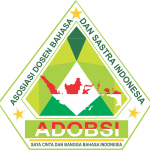THE COLLOCATION MEANING OF “VACCINE” ON SEMANTIC APPROACH: A CORPUS-BASED ANALYSIS
Abstract
Corpus semantics examines the words that are used in text and discourse using observations as evidence of meaning. This study aims to investigate the collocations of node ‘vaccine’ based on semantic preference and semantic prosody using the corpus-based approach since the source of data is the corpus data. The qualitative research method is used to find the hypotheses from the corpus data taken from sub-corpus in Covid-19 corpus using Sketch Engine software. This study demonstrates that the node word of ‘vaccine’ in the semantic preference was shown six words related to the Covid-19 corpus. Meanwhile, the category of semantic prosody was displayed four words negative in meaning, and there was two words displayed positive in meaning, the collocations with negative meaning which occur more frequently than positive meaning. Thus, the writer concluded that the author of a reputable journal explained the word ‘vaccine’ with a negative perspective in Covid-19.
Keywords
Full Text:
PDFReferences
Bagha, K. N. (2011). A short introduction to semantics. Journal of Language Teaching and Research, 2(6), 1411–1419. https://doi.org/10.4304/jltr.2.6.1411-1419
Barron, A. (2019). Using corpus-linguistic methods to track longitudinal development: Routine apologies in the study abroad context. Journal of Pragmatics, 146, 87–105. https://doi.org/10.1016/j.pragma.2018.08.015
Botella, A., Stuart, K., & Gadea, L. (2015). A Journalistic corpus: a methodology for the analysis of the financial crisis in Spain. Procedia - Social and Behavioral Sciences, 198(Cilc), 42–51. https://doi.org/10.1016/j.sbspro.2015.07.417
Cheng, W. (2011). Exploring corpus linguistics: Language in action. new york, USA: Routledge.
Dashboard | Sketch Engine. (n.d.). Retrieved July 15, 2020, from https://app.sketchengine.eu/#dashboard?corpname=preloaded%2Fcovid19
Grisot, C. (2020). Cohesion, coherence and temporal reference from an experimental corpus pragmatics perspective. In Pragmatics and Society (Vol. 11). https://doi.org/10.1075/ps.00034.zha
Klimova, B. F. (2014). Using corpus linguistics in the development of writing. Procedia - Social and Behavioral Sciences, 141, 124–128. https://doi.org/10.1016/j.sbspro.2014.05.023
Lindquist, H. (2009). Corpus linguistics and the description of English. Edinburgh University Press.
McEnery, T., & Hardie, A. (2011). Corpus linguistics: method, theory and practice. United Kingdom: Cambridge University Press.
Murphy, M. L. (2004). Corpus linguistics at work (review). Language, 80(2), 359–359. https://doi.org/10.1353/lan.2004.0092
Salama, A. H. Y. (2011). Synergy of corpus linguistics and critical discourse analysis. JSTOR, 22(3), 315–342.
Sinclair, J. (2003). Corpus, concordance, collocation. Oxford: Oxford University Press
Stubbs, M. (2001). Words and phrases: Corpus studies of lexical semantics. United Kingdom: Blackwell publishers Oxford.
Susi Yuliawati. (2016). Profil semantis nomina perempuan dalam korpus majalah berbahasa Sunda (Manglè, 1958-2013). Kongres Internasional Masyarakat Linguistik Indonesia 2016.
Tognini-Bonelli, E. (2001). Corpus linguistics at work (Vol. 6). John Benjamins Publishing.
Refbacks
- There are currently no refbacks.






